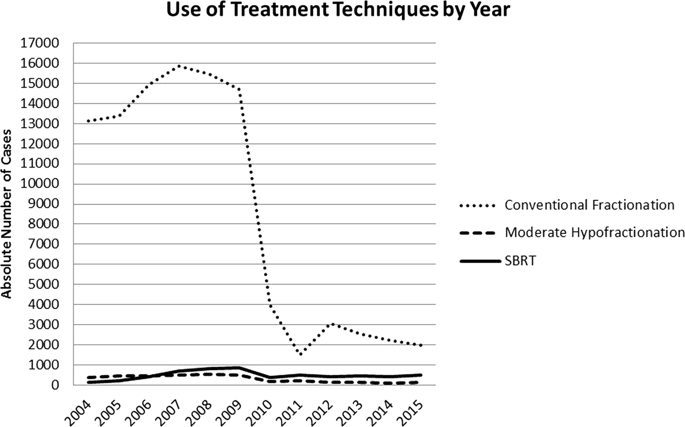当前位置:
X-MOL 学术
›
Prostate Cancer Prostatic. Dis.
›
论文详情
Our official English website, www.x-mol.net, welcomes your feedback! (Note: you will need to create a separate account there.)
Current use of stereotactic body radiation therapy for low and intermediate risk prostate cancer: A National Cancer Database Analysis.
Prostate Cancer and Prostatic Diseases ( IF 4.8 ) Pub Date : 2019-11-28 , DOI: 10.1038/s41391-019-0191-9 Timothy D Malouff 1 , William C Stross 1 , Danushka S Seneviratne 1 , Mark R Waddle 1 , Byron C May 1 , Steven J Buskirk 1 , Katherine S Tzou 1
Prostate Cancer and Prostatic Diseases ( IF 4.8 ) Pub Date : 2019-11-28 , DOI: 10.1038/s41391-019-0191-9 Timothy D Malouff 1 , William C Stross 1 , Danushka S Seneviratne 1 , Mark R Waddle 1 , Byron C May 1 , Steven J Buskirk 1 , Katherine S Tzou 1
Affiliation

|
BACKGROUND
Recent studies have demonstrated both safety and efficacy of stereotactic body radiation therapy (SBRT) as monotherapy in the treatment of low and intermediate risk prostate cancer. Our study aims to provide an update analyzing the use of SBRT compared with conventional and hypofractionated regimens in the United States from 2004 to 2015.
METHODS
This retrospective review was conducted using the National Cancer Database. We identified 114,931 patients with sufficient diagnostic and treatment information treated with definitive radiation therapy in the United States from 2004 to 2015. The relative utilization of conventional fractionation (defined as 180-200 cGy per fraction and >5 fractions), moderate hypofractionation (defined as >200 cGy per fraction and >5 fractions), and SBRT (defined as >200 cGy per fraction and 5 fractions or less) were compared over the same time period. Logistic regression models were used to estimate trends. Demographic factors were collected and analyzed using chi-squared tests and independent t-tests.
RESULTS
The proportion of prostate cancer patients receiving SBRT increased substantially from 0.9% in 2004 to 19.5% in 2015. Moderate hypofractionation exhibited some growth, increasing from 2.7% of patients to 4.7% in 2015. Conventional fractionation use declined significantly from 96.3% in 2004 to 75.8% in 2015. Notably, there was a sharp decline in the absolute number of patients receiving conventional fractionation in 2011, from 14,699 patients treated in 2009 to 1492 in 2011. Patients treated with SBRT were more likely to be treated in academic centers, younger, and have higher income than other fractionation groups. The most frequently used fractionation schedule was 3625 cGy in five fractions.
CONCLUSIONS
The use of SBRT for low and intermediate risk prostate cancer has increased significantly from 2004 to 2015, coinciding with recently published data supporting the efficacy and favorable toxicity profile of this technique.
中文翻译:

立体定向放射疗法在低危和中危前列腺癌中的当前应用:美国国家癌症数据库分析。
背景技术最近的研究表明,立体定向放射疗法(SBRT)作为单一疗法在中低危前列腺癌的治疗中既安全又有效。我们的研究旨在提供更新的信息,分析2004年至2015年美国SBRT与传统方案和常规方案相比的使用情况。方法这项回顾性研究是使用美国国家癌症数据库进行的。我们从2004年至2015年在美国确定了114,931例具有足够的诊断和治疗信息的患者,这些患者接受了明确的放射治疗。常规分级分离(定义为每级分180-200 cGy和大于5级分)的相对利用率,中度超分割(定义为> 200 cGy /馏分和> 5馏分)和SBRT(定义为> 在同一时间段内比较了200 cGy /馏分和5馏分或更少。逻辑回归模型用于估计趋势。收集人口统计学因素,并使用卡方检验和独立t检验进行分析。结果接受SBRT的前列腺癌患者比例从2004年的0.9%大幅增加到2015年的19.5%。中度超分割显示出一定的增长,从2.7%的患者增加到2015年的4.7%。常规分馏使用率从2004年的96.3%显着下降下降至2015年的75.8%。值得注意的是,2011年接受常规分馏的患者绝对数量从2009年的14699例下降到2011年的1492例。SBRT治疗的患者更有可能在学术中心接受治疗,更年轻,并且收入高于其他细分受众群。最常用的分馏方案为5个馏分中的3625 cGy。结论从2004年到2015年,SBRT用于中低危前列腺癌的使用显着增加,这与最近发表的支持该技术的功效和有利的毒性特征的数据相吻合。
更新日期:2019-11-28
中文翻译:

立体定向放射疗法在低危和中危前列腺癌中的当前应用:美国国家癌症数据库分析。
背景技术最近的研究表明,立体定向放射疗法(SBRT)作为单一疗法在中低危前列腺癌的治疗中既安全又有效。我们的研究旨在提供更新的信息,分析2004年至2015年美国SBRT与传统方案和常规方案相比的使用情况。方法这项回顾性研究是使用美国国家癌症数据库进行的。我们从2004年至2015年在美国确定了114,931例具有足够的诊断和治疗信息的患者,这些患者接受了明确的放射治疗。常规分级分离(定义为每级分180-200 cGy和大于5级分)的相对利用率,中度超分割(定义为> 200 cGy /馏分和> 5馏分)和SBRT(定义为> 在同一时间段内比较了200 cGy /馏分和5馏分或更少。逻辑回归模型用于估计趋势。收集人口统计学因素,并使用卡方检验和独立t检验进行分析。结果接受SBRT的前列腺癌患者比例从2004年的0.9%大幅增加到2015年的19.5%。中度超分割显示出一定的增长,从2.7%的患者增加到2015年的4.7%。常规分馏使用率从2004年的96.3%显着下降下降至2015年的75.8%。值得注意的是,2011年接受常规分馏的患者绝对数量从2009年的14699例下降到2011年的1492例。SBRT治疗的患者更有可能在学术中心接受治疗,更年轻,并且收入高于其他细分受众群。最常用的分馏方案为5个馏分中的3625 cGy。结论从2004年到2015年,SBRT用于中低危前列腺癌的使用显着增加,这与最近发表的支持该技术的功效和有利的毒性特征的数据相吻合。



























 京公网安备 11010802027423号
京公网安备 11010802027423号